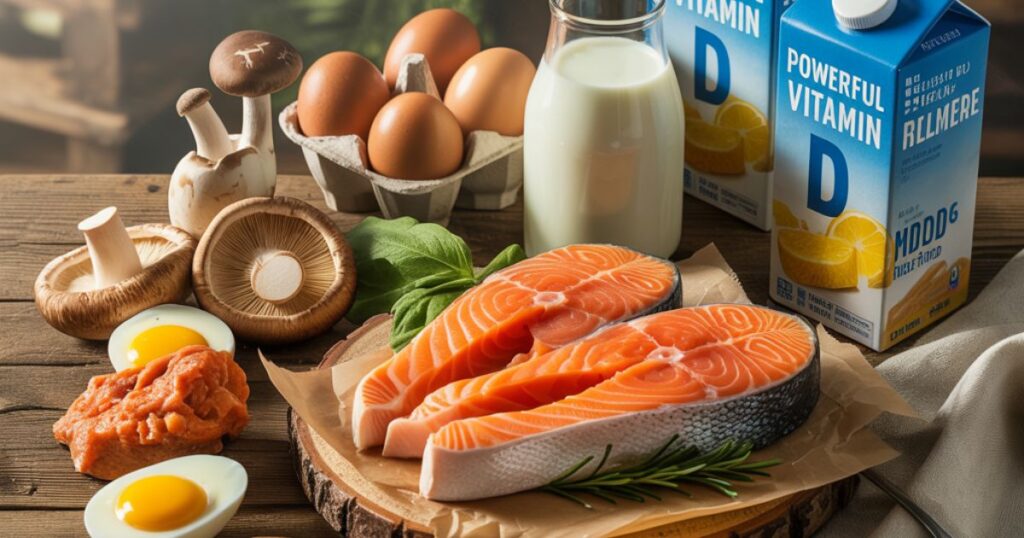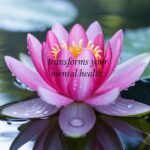Introduction: 9 Powerful Vitamin D Foods!
Getting enough Powerful Vitamin D Foods isn’t just important — it’s essential. This mighty nutrient supports your bone health, strengthens your immune system, and plays a vital role in calcium absorption. But here’s the thing: many people, especially in the U.S., don’t get enough of it.
That’s where powerful Vitamin D foods come in. By adding these nutrient-dense foods to your diet, you can fight off Vitamin D deficiency without relying solely on the sun or supplements. From fatty fish to fortified milk and juice, the right food choices make all the difference. Let’s explore how these simple additions can boost your health and energy — starting with your very next meal.
Why Your Body Needs Vitamin D Daily
Your body needs Vitamin D daily to stay strong and healthy. It helps with calcium absorption, which supports your skeletal integrity and prevents weak bones. Without enough, you’re at risk of osteoporosis, fatigue, and frequent illness. Getting the right amount supports your immune system and may lower the risk of chronic disease.
There’s a strong link between low dietary sources of vitamin D and bone health issues. Not having enough D in your body may also lead to problems with mood, muscle pain, and low energy. Many don’t realize that even if you live in a sunny place, factors like UV light exposure, age, and skin tone affect how much your body can produce from the sun. That’s why Vitamin D rich foods are so important.
How Much Vitamin D Do You Really Need?
The recommended daily intake of vitamin D varies depending on your age. Adults aged 19–70 are advised to get 600–800 IU each day. This is the daily value (DV) listed on the nutrition facts label on food products. For people over 70, 800 IU is suggested to maintain proper health.
It’s also worth noting the Vitamin D toxicity risks if too much is taken from supplements. While getting vitamin D from food is safe, taking high doses of pills can be harmful over time. Experts suggest sticking to food sources unless your doctor recommends a supplement. This is especially important during pregnancy and fish consumption, where mercury risk is also a concern.
Top Natural Sources of Vitamin D in Foods
When you think about natural vitamin D sources, think of food and sunlight. Since UV light exposure can be tricky and sun risks exist, foods high in vitamin D become key. Common items like fish, mushrooms, eggs, and fortified products give your body the vitamin D it needs without added risks.
Let’s break down some of the best options. While seafood-based vitamin D is more potent, plant-based vitamin D like UV-exposed mushrooms also contribute. You can find Vitamin D fortified foods at nearly every grocery store. These include milk, cereal, orange juice, and even some yogurts.
1. Fatty Fish – The Ultimate Vitamin D Powerhouse
Among all sources of vitamin D, fatty fish vitamin D content is the highest. Just one 3.5-ounce serving of wild salmon gives you over 500 IU—more than 70% of the daily value (DV). Other rich choices include sardines, mackerel, and herring. The salmon vitamin D content may vary by where it’s caught, but it remains a top choice.
Fatty fish are not only rich in D but also offer omega-3 fatty acids, which support heart and immune system support. These nutrient-dense foods also have excellent protein levels and taste great in a variety of dishes. You can cook them grilled, baked, or even mix into your favorite Vitamin D recipes.
2. Sunshine Mushrooms That Make Their Own Vitamin D
Mushrooms with vitamin D2 are the only non-animal vitamin D sources that naturally create this vitamin. When mushrooms are exposed to UV light, they can produce high amounts of D2, especially wild varieties like morels. One cup of UV-treated Gemini mushrooms can give you over 100% of your recommended daily intake.
While D2 isn’t as potent as D3 found in animal products, it still plays a role in raising your blood levels. These mushrooms can be a key player in your diet, especially if you’re vegetarian. They can be used in Vitamin D recipes like stir-fries, pasta, and soups. Just make sure to look for those specifically marked as UV-exposed.
3. Fortified Foods That Sneak In Vitamin D
When foods don’t naturally have vitamin D, many are made stronger through the fortification process. You’ll find fortified milk and juice, cereals, and dairy-free drinks like soy or oat milk listed with extra nutrients. A cup of fortified milk can contain up to 130 IU.
These Vitamin D fortified foods are a great option for those who don’t eat much fish or go outside often. You can spot them easily by checking the nutrition facts label. These products offer a practical and budget-friendly way to stay healthy.
4. Egg Yolks – Tiny But Nutrient-Dense
Many people skip egg yolks, but that’s where the egg yolks nutrition lives—including vitamin D. One yolk has about 40 IU. The content can be much higher in free-range eggs or eggs from hens fed with extra D.
You can boost your intake by including 2–3 eggs a few times a week. Try scrambled eggs, omelets, or egg salad. Not only are they easy to prepare, but they’re also among the simplest Vitamin D rich foods to add to your daily meals.
5. Cod Liver Oil – The Old School Supplement That Still Works
This traditional remedy is a powerhouse for cod liver oil benefits. Just one teaspoon gives you around 450 IU of vitamin D and a healthy dose of omega-3s. That’s over 50% of your daily value (DV).
The cod liver oil supplement remains popular due to its simplicity. If you don’t like the taste, you can find it in capsules too. Just be mindful of dosage, as too much can push your vitamin A levels too high. Always check with a doctor first.
Quick Recipes to Boost Your Vitamin D Intake
Adding Vitamin D rich foods into your meals doesn’t have to be boring. Think of delicious options like grilled salmon with avocado salsa or mushroom omelets with spinach. These not only give you nutrients but also taste amazing.
You can try high-impact dishes such as tuna salad with olive oil dressing or sardine toast with arugula. These quick high vitamin D meal ideas can be made in less than 20 minutes and offer a good portion of your daily value (DV).
Best Time to Eat Vitamin D Foods for Maximum Absorption
You might be wondering about the best time for vitamin D absorption. It’s most effective when eaten with fat since D is a fat-soluble vitamin. Try consuming foods high in vitamin D with meals that include healthy oils, nuts, or dairy.
Experts recommend eating these foods earlier in the day, especially breakfast or lunch. Pairing Vitamin D and calcium combo can be beneficial too. Together, they improve bone health and overall nutrient uptake, helping you feel energized all day.
| Food Item | Vitamin D (IU) | % of Daily Value (DV) |
| Wild Salmon (3.5 oz) | 556–924 | 70%–116% |
| Canned Tuna (3.5 oz) | 269 | 34% |
| Egg Yolk (1 large) | 41 | 5% |
| UV Mushrooms (1 cup) | 1100 | 139% |
| Cod Liver Oil (1 tsp) | 450 | 56% |
| Fortified Milk (1 cup) | 111 | 14% |
| Sardines (3.5 oz) | 193 | 24% |
| Orange Juice (1 cup) | 100 | 12% |
Quote to Remember:
Let food be thy medicine, and medicine be thy food. – Hippocrates
Trusted Source citation:
National Institutes of Health – vitamin D Fact Sheet
Now that you know the best foods high in vitamin D, it’s time to act. Start adding these simple, delicious items to your plate today. It’s not just about health—it’s about feeling your best every single day.
FAQs:
What food has the highest vitamin D?
Wild salmon has the highest vitamin D, offering up to 924 IU per 100g.
How can I raise my vitamin D levels quickly?
Eat vitamin D rich foods, take supplements, and get short, safe sun exposure.
What drink is high in vitamin D?
Fortified milk and juice, especially orange juice and soy milk, are high in vitamin D.
Are 2 eggs a day enough vitamin D?
No, 2 eggs provide only about 10% of the daily value (DV) for vitamin D.
How do you get 100% vitamin D?
Combine fatty fish, UV-exposed mushrooms, or cod liver oil supplement to meet 100% DV.
Does cooking eggs destroy vitamin D?
Yes, cooking slightly reduces vitamin D, but most of it remains intact.




Pingback: Low-Calorie Diet Meal: 30+ Delicious Ideas for Weight Loss